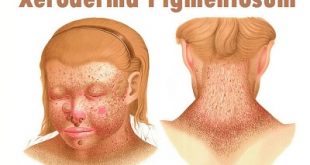Definition
Xerophthalmia is a medical condition in which the eye film is reduced and the eye is incapable of producing tears. This appears when there is something wrong with lacrimal glands and their main function, meaning to produce tears, is affected. Xerophthalmia is also known as the dry eye syndrome or conjunctivitis arida and it can affect the quality of life to an extensive level.
The tears are very important to the health of our eyes, because they actually keep it lubricated. Without eye film, we would never be protected against particles and debris coming from the outside. This is why having healthy tear film also guarantees healthy eyes, meaning a good vision as well.
Stages of xerophthalmia
Severe xerophthalmia is virtually confined to infants and young children and usually associated with protein-energy malnutrition. The stages are classified by the WHO as follows.
- Night blindness (XIN) is the earliest symptom but not elicited in infants.
- In conjunctival xerosis (XIA) one or more patches of dry non-wettable conjunctiva emerge “like sand banks at receding tide” when the child ceases to cry. It is caused by keratinising squamous metaphasia of the conjunctiva.
- Bitot’s spots (XIB) are glistening white plaques formed of desquamated thickened epithelium, usually triangular and firmly adherent to the underlying conjunctiva.
- Corneal xerosis (X2) is a haziness or a granular pebbly dryness of the cornea on routine light examination, beginning in the inferior cornea.
- Corneal ulceration (X3A) or keratomalacia (X3B).
History behind xerophthalmia
For thousands of years humans and animals have suffered from vitamin A deficiency, typified by night blindness and xerophthalmia. Night blindness was described in ancient Egypt and was thus the earliest recognized deficiency disease. Eber’s papyrus an Egyptian medical treatise between 1520 to 1600 BC, recommended eating roasts ox liver or liver of black cocks, to cure it.
The old Greek, Roman and Arab physicians recommended an internal and external, therapy, with livers of goats to overcome night blindness.
Celsus (25 BC to AD 50), s roman author on medicine, was the first to describe xerophthalmia but his recommendation for treatment did not mention liver.
The term ‘xerophthalmia’ was coined nearly 200 years ago to describe dry eyes – xeros in Greek means dryness.
Clinical descriptions of corneal xerophthalmia first appeared in England in the 18th century, followed by additional reports in the 19th century and early 20th centuries of its occurrence.
By the end of the nineteenth century, xerophthalmia was recognized in many parts of the world including continental Europe, the UK, the USA and some tropical countries.
Xerophthalmia has since become synonymous with the ocular manifestations of vitamin A deficiency.
Epidemiology
Xerophthalmia usually affects children under nine years old and “accounts for 20,000-100,000 new cases of childhood blindness each year in the developing countries.” The disease is largely found in developing countries like many of those in Africa and Southern Asia. The condition is not congenital and develops over the course of a few months as the lacrimal glands fail to produce tears. Other conditions involved in the progression already stated include the appearance of Bitot’s spots, which are clumps of keratin debris that build up inside the conjunctiva and night blindness, which precedes corneal ulceration and total blindness.
Causes of xerophthalmia
These are the most common causes that leads to the appearance of xerophthalmia:
- Vitamin A deficiency (Primary cause)
- Aging
- Poor closure of the eyelids
- Previous injuries or traumas (accompanied by scarring)
- Autoimmune disorders (rheumatoid arthritis, sjogren’s syndrome, lupus)
- Radiotherapy (often transient but cases of permanent damage have been reported)
- Medication (medication for nasal congestion, sedatives, medication against allergies, such as anti-histamines)
- Chemical burns
Who’s at risk for xerophthalmia?
The major risk for xerophthalmia is poverty and lack of adequate diet, especially a lack of animal products. Infants and children are at greater risk. The younger the child, the more severe the effects of vitamin A deficiency.
Children require a lot of vitamin A in order to grow. Vitamin A deficiency also affects the ability to survive common childhood infections and diseases, such as diarrhea, measles, and respiratory infections.
Other risk factors affect a much smaller number of people in the United States and other countries. The following are risk factors because they affect a person’s ability to absorb vitamin A:
- Alcoholism
- Cystic fibrosis
- Diseases such as celiac disease that limit the absorption of nutrients
- Liver disease, such as cirrhosis
- Chronic diarrhea
- Radioiodine treatment for thyroid cancer, which may produce nonpermanent symptoms of xerophthalmia
Symptoms of xerophthalmia
The earliest symptoms of Xerophthalmia include mild irritation, hot discomfort, Bitot’s spot, corneal xerosis and a desire to blink continuously. There are some common symptoms of xerophthalmia are:
- Night blindness: The night blindness is first symptoms of vitamin A deficiency. It means unable to see the object in the evening, during night or in dim light.
- Conjunctival xerosis: This means dryness of the conjunctiva eye become dry and non wettable.
- Bitot’s spots: Bitot’s spots are foamy triangular spots that are pearly or yellow in color which is seen either the cause of cornea.
- Corneal xerosis: This is a serious form of vitamin A deficiency. In this cornea becomes dry, opaque, dull and non wettable.
- Keratomalacia: If vitamin A deficiency is untreated then this condition is called keratomalacia. In this the eye can be lost, eye collapses, and vision is lost. keratomalacia are the leading causes of blindness.
- Simple irritation
- Burning sensation
- Redness
- Itch – Sustained sensation of sand in the eyes
- Blurry vision that improves with blinking
- Increase in symptoms after reading, watching TV or working at a computer
- Difficulty in wearing contact lensesLacrimation
- Lacrimation
- Intense eye irritation from smoke or wind
Diagnosis
- The diagnosis will involve a physical examination. In addition, the doctor is likely going to ask about your diet and the symptoms you are getting.
- A blood test can help to check the amount of vitamin A in your blood.
- An examination at the slit lamp can show atrophy and dryness of the conjunctiva in case of xerophthalmia.
- In some cases, corneal ulcers that arise due to xerophthalmia has been attributed to bacterial infection and in some cases antibiotics has been prescribed.
Treatment for xerophthalmia
These are athe most common courses of treatment for the symptoms of xerophthalmia:
- Eye drops containing artificial tears (help renew the tear film and preent eye dryness)
- Air humidifiers (keeping the air in the room humid will help prevent eye dryness as well)
- Wrap around glasses for the outside (this is extremely important, as the lack of tear film will contribute to debris to enter the eye, causing serious infections; plus, the wind can cause even more dryness)
- In case of corneal ulcerations, the most recommended course of treatment is the surgical intervention
- Retinol injections are indicated, especially in patients that have severe diarrhea or vomit persistently
- Women of reproductive age should not receive large doses of vitamin A which are contra-indicated in pregnancy. If a woman has night blindness or Bitot’s spot she should have a daily dose of 10,000 IU of vitamin A orally for 2 weeks.
If xerophthalmia is caused by the lack of vitamin A, then there are two ways to go:
- Vitamin A fortification (Vitamin A supplements)
- Diet change to include foods that are rich in vitamin A in the diet (carrots, dark green leafy vegetables, deep yellow feruits, sweet potatoes, squash,lettuce, dried apricots, sweet red peppers, tuna fish, mangoand other tropical fruits, cod liver oil, turkey liver, paprika spices, whole milk, dried basil, peas, cantaloupe, tomatoes, marjoram, spinach).
How can we prevent xerophthalmia?
There are a number of approaches to the prevention of vitamin A deficiency in children.
- Education in nutrition is required to encourage breast feeding. Colostrum and breast milk contain vitamin A.
- Weaning foods should be rich in vitamin A, for example, mango or papaya. Dark green leafy vegetables (DGLV) may be given at one year and older.
- Encourage the planting of small gardens with advice as to which fruits and vegetables should be grown. Examples are shown top right – mango, papaya, dark green leafy vegetables and carrots.
- Overcooking and drying fruits in the sun both reduce the vitamin A content of foods.
- Vitamin A capsules 200,000 IU may be given every 3 to 6 months to children aged 1 to 6 years of age who are at high risk.
- A programme of measles immunization should be planned and carried out.
- Foods may be fortified with vitamin A, for example, by fortifying a widely used food such as sugar and milk which has been prepared from powdered milk fortified with vitamin A and vitamin D.
 Diseases Treatments Dictionary This is complete solution to read all diseases treatments Which covers Prevention, Causes, Symptoms, Medical Terms, Drugs, Prescription, Natural Remedies with cures and Treatments. Most of the common diseases were listed in names, split with categories.
Diseases Treatments Dictionary This is complete solution to read all diseases treatments Which covers Prevention, Causes, Symptoms, Medical Terms, Drugs, Prescription, Natural Remedies with cures and Treatments. Most of the common diseases were listed in names, split with categories.








Please i have a problem with a side of my eye,a side of my eye is dim,what is the way out thanks.
It can be a sign of eye blindness. So please consult with any ophthalmologist ASAP.
And i also have a eye scratching
It might also due to an allergy. Please consult with an ophthalmologist to reduce the development of this problem in to further serious conditions.
please my eyes look dim at image when I look far. what’s the remedy.
any time my eyes are red i can,t understand what is the problem please solve may problem
It might be due to the dust from environment or due to some nerves that connect to the eye from brain. Consult a doctor and get to know the reason for cure.
Please help,I have a son,four years old, his eyes are most of times read,they are also itching much,he has never complained of pain or signs of blindness but its really affecting him,what could be a problem?
Please consult an ophthalmologist.